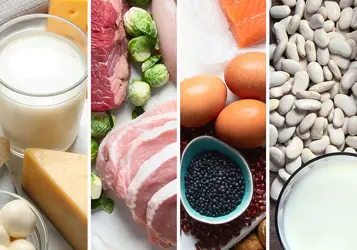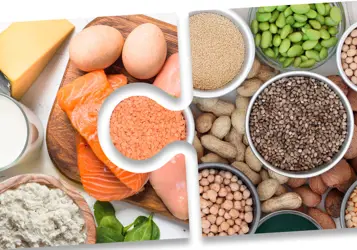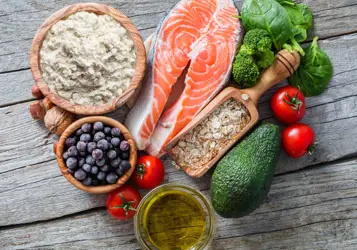There has been an increasing focus on the importance of sustainability with regard to protein in recent years. Because plant-based protein sources tend to have a lower carbon footprint, there is now a big push for people to move towards 100% plant-based diets.
I see that as an extreme approach. Eliminating animal-based protein sources is not only unrealistic for cultural reasons – there could be health implications too.
Maintaining and building muscle mass through muscle protein synthesis (MPS) is an important part of healthy ageing1, and the available evidence suggests animal proteins have several benefits over plant-based sources.
Understanding protein quality
There are three main factors that determine the quality of a protein source.
The first relates to digestion and absorption kinetics – how effectively the amino acids can get through the intestine and into the bloodstream so they are available to the skeletal muscle. While the science is not yet conclusive, there is evidence to suggest that getting the amino acids into the bloodstream faster can act as a trigger to activate the MPS2.
The second concerns the essential amino acid (EAA) profile and content. The best protein sources contain all nine EAAs in sufficient quantities, providing all the materials needed to build muscle mass. We often use the analogy of building a brick wall: if you’re missing any of the key materials, you can’t complete the wall.
The third factor is the leucine content. Leucine is an EAA and one of three branched-chain amino acids. The reason leucine is so important is because it not only provides substrate, which is a building block for the muscle, but it also acts as a signal to switch on the MPS process. To continue the wall analogy, leucine functions as both a brick and a cup of coffee that sparks the builders into action.
Based on these criteria, animal proteins are generally superior to plant-based proteins, with whey protein representing the gold standard. Animal proteins tend to be more rapidly digested and absorbed than plant proteins, which can contain non-digestible material. They also generally have a superior EAA profile and a higher leucine content.
These advantages help explain why studies comparing animal and plant proteins have shown a greater MPS response in relation to animal proteins.
There is still more research to be done, with studies3 so far only comparing dairy proteins to soy and wheat proteins. Even so, the results to date support the argument that animal protein sources are better suited to maintaining and building muscle mass.
How much protein is needed?
Consuming sufficient protein quantity is another key part of stimulating MPS. Our current recommendation is between 0.25 and 0.3g of per kilogram of body mass per meal for a younger adult, rising to around 0.4g for older adults.
That protein also needs to contain sufficient leucine. There is evidence to suggest physical activity can reduce leucine requirements4 but, in general, a younger adult needs around 2g to maximally stimulate MPS, rising to around 3g for older adults.
Differences in leucine levels between different protein sources also affect the amount of protein required overall.
Plant proteins tend to be low in leucine, whereas the levels in dairy proteins, and whey in particular, are very high. Although some plant sources, such as potato protein, have a complete EAA profile5, you would still need to consume greater quantities to stimulate MPS than with a dairy protein because the leucine content is so much lower.
A healthy approach to protein intake
There is no question that we need to consider the sustainability of the protein we consume, and animal proteins are generally at the higher end of the spectrum when it comes to greenhouse gas emissions.
However, the suggestion that we should move solely to plant proteins is too radical. Like many aspects of nutrition, I believe things have been blown out of proportion and a more balanced approach is needed.
While plant-based proteins can form an important part of a healthy and sustainable diet, they tend to have lower digestibility, inferior EAA profiles and lower leucine content. By including high-quality proteins such as whey into our diets, we are far better placed to meet MPS requirements and maintain healthy muscle mass into old age.
Citations
1 Witard, O.C., McGlory, C., Hamilton, D.L. et al. Growing older with health and vitality: a nexus of physical activity, exercise and nutrition. Biogerontology 17, 529–546 (2016). https://doi.org/10.1007/s10522-016-9637-9
2 Witard, O. C., Wardle, S. L., Macnaughton, L. S., Hodgson, A. B., & Tipton, K. D. (2016). Protein Considerations for Optimising Skeletal Muscle Mass in Healthy Young and Older Adults. Nutrients, 8(4), 181. https://doi.org/10.3390/nu8040181
3 Phillips, Stuart & Tang, Jason & Moore, Daniel. (2009). The Role of Milk- and Soy-Based Protein in Support of Muscle Protein Synthesis and Muscle Protein Accretion in Young and Elderly Persons. Journal of the American College of Nutrition. 28. 343-54. 10.1080/07315724.2009.10718096.
4 Breen, L., & Phillips, S. M. (2011). Skeletal muscle protein metabolism in the elderly: Interventions to counteract the 'anabolic resistance' of ageing. Nutrition & metabolism, 8, 68. https://doi.org/10.1186/1743-7075-8-68
5 https://pdfs.semanticscholar.org/985c/cc92c9dc594600ad2e7d285c84675ebaeb4b.pdf%20Plant
This blog contains material and information intended for B2B customers, suppliers and distributors, and is not intended as information to the final consumers.
























